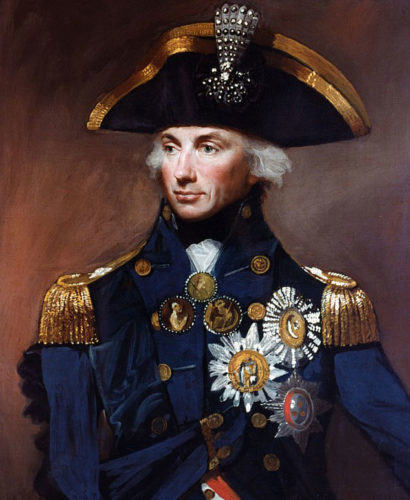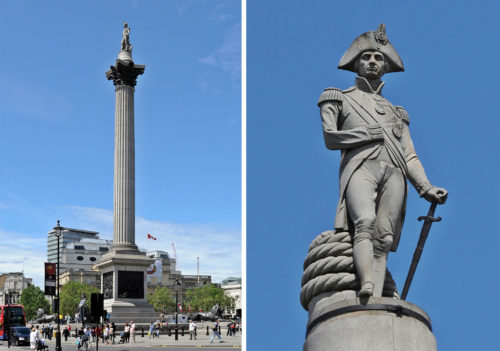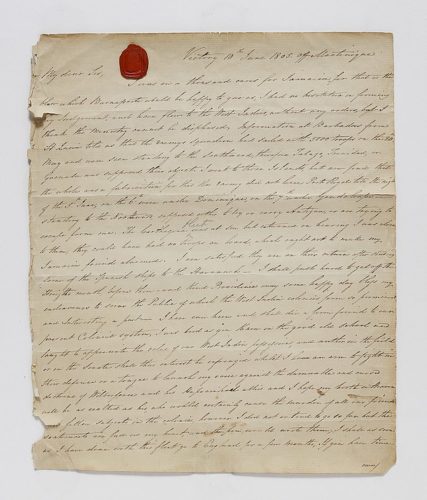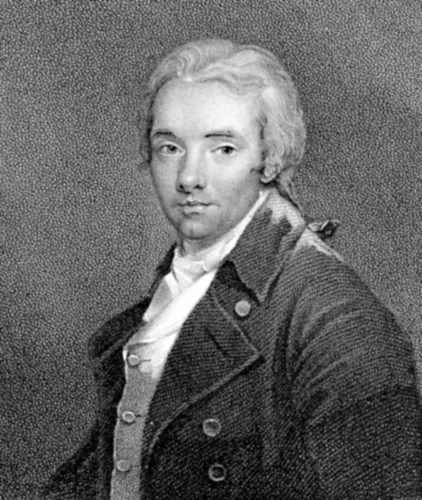
Lemuel Francis Abbott painted Admiral Horatio Nelson’s portrait in 1797. It now hangs at 10 Downing Street in London. [National Maritime Museum]
Martyn Downer says he has incontrovertible evidence the original letter written by Admiral Horatio Nelson aboard HMS Victory four months before he died at the pivotal Battle of Trafalgar was doctored by supporters of the slave trade to counter moves in the British Parliament to outlaw the practice.
“The letter is a forgery,” wrote Downer, a former director at Sotheby’s and leading specialist in the identification of Nelson- and Royal Navy-related artifacts.
“It lays bare the lengths that opponents to the abolition of the slave trade were prepared to go to further their cause by hijacking the reputation of the man who defeated the French at Trafalgar.”
The author of two books on Nelson, Downer published his research as the National Maritime Museum in Greenwich embarked on a review of the one-armed hero’s status, due to what it called his “complex” role in Britain’s transatlantic slave trade.
“Its crafters made more than two dozen changes to the original document, and added a fake signature.”
The controversy swelled amid re-evaluations in Europe and North America, particularly, of the roles revered figures played in some of history’s great injustices.
The rethinking began with Confederate generals in the United States and has since spread to include the likes of Canadian icons Edward Cornwallis, who as an 18th-century Nova Scotia governor placed bounties on the scalps of Mi’kmaqs, and Canada’s first prime minister, John A. Macdonald, who has come under scrutiny for his role in the Chinese Head Tax and First Nations policies.
In Britain, the controversies have reached onetime “untouchables” such as Nelson and former prime minister Winston Churchill, whose stellar Second World War leadership did mask a chequered past. Their views and deeds have come under scrutiny as part of a reckoning with the country’s imperialist history and its associated injustices.

Nelson’s Column in Trafalgar Square in Westminster commemorates Admiral Horatio Nelson, who died at the Battle of Trafalgar in 1805. [Wikimedia]
His Oct. 21, 1805, victory against a superior force of French and Spanish ships west of Cape Trafalgar, Spain, secured the English Channel, shattered French designs on the British Isles, and set the table for Britannia to rule the waves for the next 100 years.
Nelson’s fleet destroyed 22 enemy vessels at Trafalgar. The British lost none. But, with his place in history seemingly assured, Nelson died more than three hours after he was shot by a French sharpshooter, his last words, as recorded by ship’s chaplain Alexander Scott: “God and my country.”
His apparent views on slavery were thrust to the fore in 2017 when writer/broadcaster Afua Hirsch labelled Nelson a “white supremacist” for supposedly using his parliamentary seat to vigorously defend the slave trade on behalf of wealthy, plantation-owning friends.
In fact, Downer reports, Nelson only ever spoke six times in the House of Lords and never on the slave trade.
“The suggestion that he did—which has been endlessly seized on by his detractors—originates with that explosive letter the Admiral wrote to slave owner Simon Taylor,” Downer wrote recently in the Daily Mail.
The document was made public two years after Nelson penned the original aboard Victory off the Caribbean island of Martinique on June 10, 1805. It landed shortly before the Commons was to vote on MP William Wilberforce’s bill to abolish the slave trade.
In it, Nelson purportedly vowed to “launch my voice against the damnable and cursed doctrine of Wilberforce and his hypocritical allies.” That was ample enough ammunition for Hirsch to call for Nelson’s column in Trafalgar Square to be removed while other monuments in southeast London and Norwich were toppled.
Cobbett…tampered with the contents before publishing the altered version.
Except the words were not Nelson’s. Downer, who discovered the forgery in a private collection, says its crafters made more than two dozen changes to the original document, and added a fake signature and false wax seal.
“It is a valuable addition to the Nelson archive—and to the general historical record,” Downer said, “because it shows how the anti-abolitionists cynically exploited Nelson’s posthumous fame in a last-ditch effort to bring down Wilberforce’s Bill.”
Nelson’s original letter to Simon Taylor is lost and presumed destroyed. Unknown to the anti-abolitionists, however, the admiral had kept a “pressed” copy—like an early carbon copy—in his rarely viewed private files, now in the British Library.
Downer says the alterations are clear. Many were minor and editorial but “overall were designed to rally the dead hero’s support for their lost cause.” In the key passage, Nelson did not write “against the damnable and cursed doctrine” of abolition, as the doctored version had it.
The original wording was “against the damnable cruel doctrine” and, according to Downer, “he was referring to the consequences of freeing slaves to face possible starvation and massacre in the chaos that would follow.”
“Nelson had read reports of slave uprisings in Guadeloupe, St Domingo, Dominica and elsewhere which had resulted in the killing of thousands of people, black and white alike,” the antiquities dealer wrote. “He feared the anarchy and violence that Wilberforce’s Bill might unleash.
“Of course, the slave-owning planters were not interested in such humanitarian niceties, only in the economic consequences to themselves of abolition. They spun Nelson’s words to their advantage before publication.”
Nelson never owned slaves nor a plantation, never took part in slaving activities at sea and never financed a slave ship. During his early career, he was stationed in the Caribbean but made just the one brief visit there after 1787, when he chased French ships across the Atlantic over concern they had their eyes on the British colony of Jamaica. He failed to find the French fleet, and Jamaica was never taken.
As a Royal Navy officer, Downer points out, Nelson’s primary task was to protect British trade, which then included the slave trade.
He was a stickler for duty, as evoked in his famous last signal at Trafalgar, “England expects that every man will do his duty,” and so, like his fellow officers, Downer contends, “he never questioned this deplorable task.”

(Click on photo to enlarge) Anti-abolitionists changed a copy of Nelson’s letter after his death to influence a Parliamentary vote on slavery. [Daily Mail]
Downer says Nelson had only one friend in the West Indies—merchant Hercules Ross, a high-profile abolitionist campaigner who testified at the parliamentary hearings into the slave trade.
“Most of the other planters in the West Indies hated Nelson for rigorously enforcing the shipping laws they liked to flout and to which other Royal Naval station commanders turned a blind eye,” Downer said.
“They had physically threatened him on occasion, forcing him to live aboard his ship, then pursued him to England with legal writs.”
As a recent station commander in the West Indies, Downer added, it might have been expected that Nelson would also appear at the slave trade hearings. And while other naval officers of similar or higher rank did attend and argued in favour of the trade in human cargo, Nelson did not, despite being in England at the time.
He freed 30 galley slaves held in Portuguese ships in 1799.
“Nelson’s absence from the inquiry is telling,” Downer said. “He was no friend of the planters, but nor would it have been prudent to stick his neck out against his colleagues and senior officers.”
The man he wrote the letter to, Simon Taylor, was an acquaintance of 30 years. Nelson was seeking a favour on behalf of the same chaplain, Alexander Scott, who recorded his last words four months later. Scott, a close friend of Nelson’s and previously his private secretary, was hoping to land a placement in Jamaica.
“To curry favour with the powerful Taylor, it is clear Nelson shaped his letter to reflect his correspondent’s fierce anti-abolition views and for Taylor that was a gift, the value of which rose exponentially when Nelson died just months later at Trafalgar, and his ‘immortal memory’ achieved near god-like status.”
Taylor sent the letter to journalist William Cobbett, an ardent anti-abolitionist. It was Cobbett who tampered with the contents before publishing the altered version in his influential Political Register, said Downer. It was then brandished around the coffee houses of Westminster as the anti-abolitionists sought to drum up support.

British MP William Wilberforce introduced a bill to abolish the slave trade.
Wilberforce’s Slave Trade Act of 1807 passed nevertheless, prohibiting dealing in slaves, and was enforced by the Royal Navy’s newly created West Africa Squadron—manned, no doubt, by sailors who once defended the trade.
The Slavery Abolition Act of 1833 would follow, formally freeing 800,000 Africans who remained the legal property of slave owners in the British Empire—not all, by any means. The same act compensated 46,000 slave owners to the tune of £20 million, via the British taxpayer, for their losses.
At 40 per cent of government expenditures in 1834, it was the largest bailout in British history until 2009, when Westminster enacted the bank rescue package in the midst of the global financial crisis. The slaves received nothing and were, in fact, required to provide their former masters with 45 hours of unpaid labour each week for another four years. Still others were enslaved until 1843, or later.
“More than 8,000 letters by Nelson have been published,” wrote Downer. “I have read most if not all of them, and with the exception of his attitude towards the French, whom he hated with a passion, I have not found a single comment which could be construed as racist, and certainly not about enslaved black people.
“He did not share the deplorable attitudes towards race that many others did in the 18th century. After all, his life depended utterly on the multicultural, ethnically diverse crews of his ships.”
As a young man, Nelson had sailed the Arctic with Olaudah Equiano, a freed slave who became a hero among abolitionists, and whenever Nelson had an opportunity to personally intervene on behalf of enslaved people, he took it, said Downer.
He freed 30 galley slaves held in Portuguese ships in 1799, and employed freed slaves in his household—among them Fatima, a young girl discovered in a French warship who became Emma Hamilton’s maid.
Downer, who in 2019 discovered a pencil sketch Nelson made of his battle plan for Trafalgar pasted in a Victorian scrapbook, says the admiral even lent his support to a scheme to replace slave labour in the West Indies with paid labour from China. The idea was soon squashed by the planters’ lobby.
“As the National Maritime Museum seeks to address issues raised by the [Black Lives Matter] movement,” wrote Downer, “it is to be hoped that it recognises that history, like politics, is a dirty game and that the truth is not always what is seems.
“Nor is it necessarily written by the winners.”
Advertisement





















